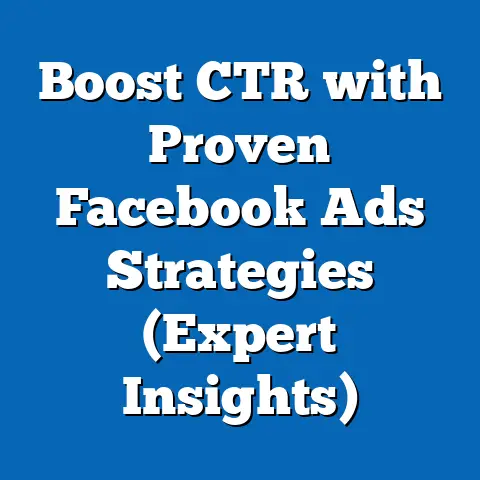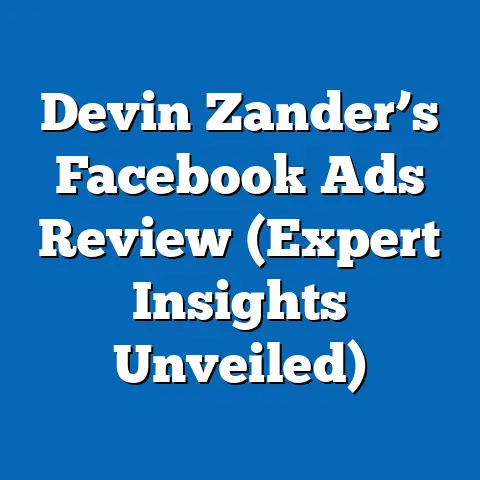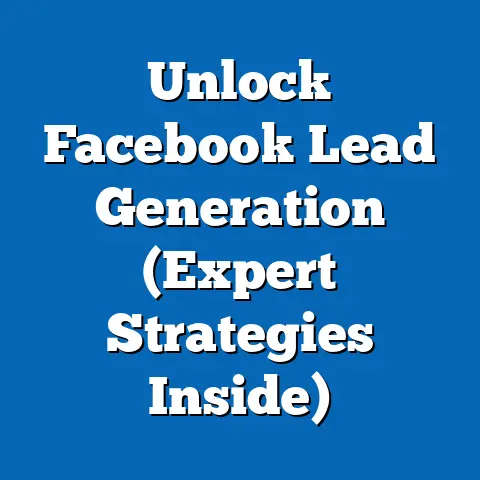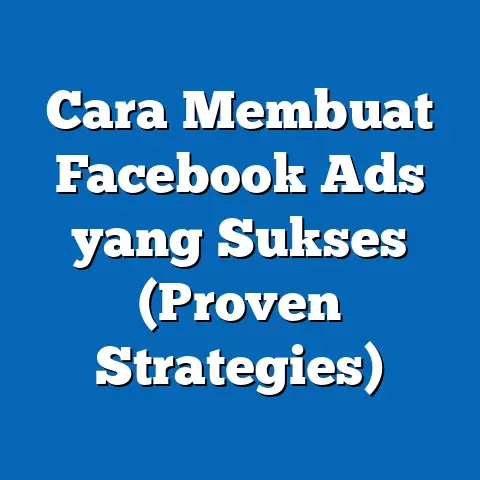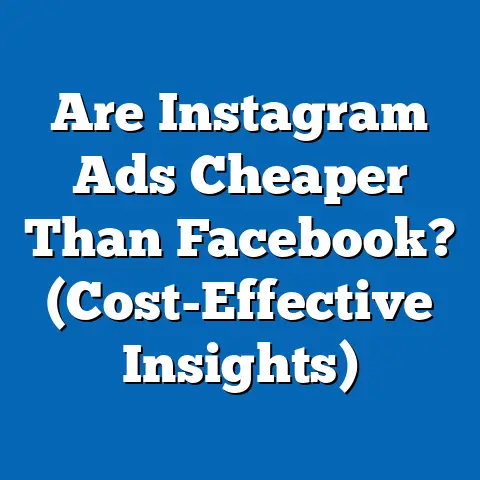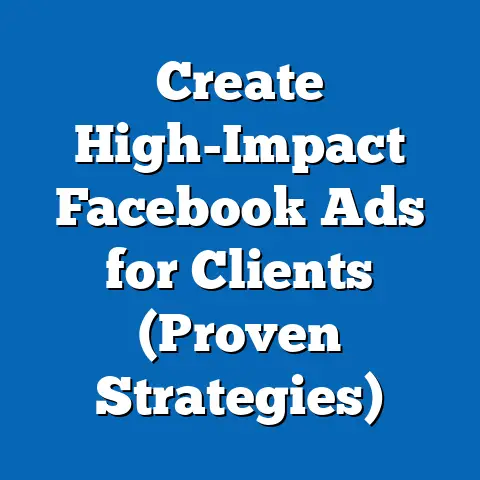Unlock Global Reach with Facebook Ads (Expert Strategies)
In today’s interconnected world, the ability to reach a global audience is no longer a luxury, but a necessity for businesses seeking sustainable growth. The digital marketplace has dissolved geographical boundaries, presenting unprecedented opportunities for brands to connect with customers across the globe. And at the forefront of this global expansion lies Facebook Ads – a powerful tool that, when wielded correctly, can unlock unparalleled reach and drive significant business outcomes.
Think about it: Facebook boasts billions of active users worldwide, spanning diverse demographics, interests, and cultures. This vast network presents a goldmine for businesses aiming to tap into international markets. I’ve personally witnessed the transformative power of Facebook Ads, helping small startups grow into international brands simply by leveraging the platform’s sophisticated targeting capabilities.
But it’s not enough to simply “run ads” on Facebook. To truly unlock global reach, you need a strategic, data-driven approach that considers cultural nuances, leverages advanced targeting techniques, and continuously optimizes for performance. Over the years, I’ve seen countless businesses stumble with their global Facebook ad campaigns, often due to a lack of understanding of the platform’s intricacies or a failure to adapt their strategies to different markets.
According to Statista, Facebook’s global advertising revenue reached over $117 billion in 2022, highlighting the platform’s dominance in the digital advertising landscape. Moreover, emerging markets like India and Brazil are experiencing explosive growth in Facebook usage, presenting significant opportunities for businesses looking to expand into these regions.
The shift in consumer behavior towards online shopping is also undeniable. E-commerce sales are projected to continue their upward trajectory, and Facebook Ads provide a direct avenue for businesses to capitalize on this trend by reaching potential customers at every stage of the buying journey.
So, whether you’re a seasoned marketer looking to refine your global Facebook Ads strategy or a business owner just starting to explore the platform’s potential, this guide is for you. Let’s dive in and unlock the power of Facebook Ads to achieve your global ambitions.
Understanding Facebook Ads
At its core, Facebook Ads is a paid advertising platform that allows businesses to display targeted ads to users on Facebook, Instagram, Messenger, and the Audience Network. These ads can take various forms, including:
- Image Ads: Simple yet effective, image ads feature a single image with accompanying text.
- Video Ads: More engaging than image ads, video ads allow you to showcase your product or service in action.
- Carousel Ads: These ads display multiple images or videos in a scrollable format, perfect for showcasing a range of products or features.
- Slideshow Ads: A lightweight video format that combines multiple images with music or voiceover.
- Collection Ads: Designed for e-commerce, collection ads feature a main image or video followed by a grid of related products.
- Lead Ads: These ads allow users to submit their contact information directly within the Facebook platform, making it easy to generate leads.
The effectiveness of each ad format depends on your specific goals and target audience. For example, I’ve found that video ads tend to perform exceptionally well for brand awareness campaigns, while carousel ads are ideal for showcasing a product catalog.
The Ad Auction System
Facebook Ads operate on an auction system, where advertisers bid for ad space based on factors like their target audience, budget, and ad quality. Facebook’s algorithm then determines which ads to show based on a combination of bid amount, estimated action rates (how likely users are to engage with the ad), and ad quality.
To optimize your bids for better visibility, it’s crucial to understand how the auction system works. You can choose between various bidding strategies, including:
- Lowest Cost: Facebook automatically bids to get you the most results for your budget.
- Cost Per Result Goal: You set a target cost per result, and Facebook tries to achieve that target.
- Bid Cap: You set a maximum bid amount, and Facebook won’t bid higher than that.
- Manual Bidding: You have full control over your bids.
I often recommend starting with the “Lowest Cost” bidding strategy to gather data and then switching to a more targeted strategy like “Cost Per Result Goal” or “Bid Cap” once you have a better understanding of your campaign performance.
The Facebook Ads Manager
The Facebook Ads Manager is your central hub for creating, managing, and tracking your Facebook Ad campaigns. It’s a powerful tool that provides a wealth of features, including:
- Audience Targeting: Define your ideal audience based on demographics, interests, behaviors, and more.
- Budgeting: Set your daily or lifetime budget and control your ad spend.
- Ad Creative: Design and upload your ad creatives, including images, videos, and text.
- Performance Tracking: Monitor your campaign performance and track key metrics like impressions, clicks, conversions, and return on ad spend (ROAS).
I’ve spent countless hours navigating the Facebook Ads Manager, and I can tell you that mastering its features is essential for successful Facebook advertising. Take the time to explore the different options and experiment with various settings to find what works best for your business.
The Facebook Pixel
The Facebook Pixel is a small snippet of code that you place on your website to track user actions, such as page views, add-to-carts, and purchases. This data is then used to:
- Retarget users: Show ads to people who have previously visited your website.
- Track conversions: Measure the effectiveness of your ad campaigns by tracking how many people convert after clicking on your ads.
- Optimize your ads: Improve your ad targeting and bidding strategies based on conversion data.
The Facebook Pixel is an indispensable tool for any business serious about Facebook advertising. It allows you to measure the impact of your campaigns and optimize your strategies for maximum ROI. I’ve seen firsthand how implementing the Facebook Pixel can dramatically improve conversion rates and drive significant revenue growth.
Key Takeaway: Facebook Ads is a versatile platform with a range of ad formats, bidding strategies, and targeting options. Mastering the Facebook Ads Manager and implementing the Facebook Pixel are crucial for successful Facebook advertising.
Next Steps: Familiarize yourself with the Facebook Ads Manager and install the Facebook Pixel on your website. Experiment with different ad formats and bidding strategies to find what works best for your business.
Identifying Your Target Audience
One of the most critical aspects of successful Facebook advertising is identifying your target audience. You can’t simply throw ads out into the ether and hope they resonate with the right people. You need to define your ideal customer and then use Facebook’s targeting options to reach them effectively.
Audience segmentation involves dividing your target market into smaller groups based on shared characteristics like demographics, interests, behaviors, and location. This allows you to create more targeted and relevant ad campaigns that resonate with specific segments of your audience.
Facebook’s Targeting Options
Facebook offers a wealth of targeting options that allow you to narrow down your audience and reach the people most likely to be interested in your product or service. These options include:
- Demographics: Target users based on age, gender, education, relationship status, job title, and more.
- Interests: Target users based on their interests, hobbies, and the pages they like on Facebook.
- Behaviors: Target users based on their online behaviors, such as purchase history, device usage, and travel habits.
- Location: Target users based on their location, from broad regions like countries to specific cities or zip codes.
- Custom Audiences: Target users based on your own customer data, such as email lists, website visitors, and app users.
- Lookalike Audiences: Create audiences that are similar to your existing customers, allowing you to reach new potential customers who share similar characteristics.
I’ve found that combining multiple targeting options can be particularly effective. For example, you could target women aged 25-45 who are interested in fitness and live in a specific city. This level of granularity allows you to create highly targeted ad campaigns that resonate with your ideal customer.
Lookalike Audiences
Lookalike audiences are a powerful tool for expanding your reach and finding new potential customers. By leveraging your existing customer data, Facebook can create an audience that is similar to your best customers, allowing you to reach people who are likely to be interested in your product or service.
To create a lookalike audience, you need to provide Facebook with a “seed audience,” which is a list of your existing customers or website visitors. Facebook then analyzes the characteristics of this seed audience and creates a new audience that shares similar traits.
I’ve personally used lookalike audiences to drive significant growth for my clients. By targeting people who are similar to their best customers, we’ve been able to increase conversion rates and lower customer acquisition costs.
Examples of Successful Global Campaigns
To illustrate the power of effective audience targeting, let’s look at some examples of successful global Facebook ad campaigns:
- Airbnb: Airbnb uses Facebook Ads to target travelers in specific locations with ads for local accommodations. They also leverage lookalike audiences to reach new potential customers who are similar to their existing users.
- Nike: Nike uses Facebook Ads to target athletes and fitness enthusiasts with ads for their latest products and apparel. They also use behavioral targeting to reach users who have recently purchased athletic gear online.
- Spotify: Spotify uses Facebook Ads to target music lovers with ads for their premium subscription service. They also use retargeting to re-engage users who have previously visited their website or downloaded their app.
These examples demonstrate the importance of understanding your target audience and using Facebook’s targeting options to reach them effectively. By creating targeted ad campaigns that resonate with specific segments of your audience, you can drive significant results and achieve your global business goals.
Key Takeaway: Identifying your target audience is crucial for successful Facebook advertising. Use Facebook’s targeting options to reach the people most likely to be interested in your product or service. Leverage lookalike audiences to expand your reach and find new potential customers.
Next Steps: Define your ideal customer and then use Facebook’s targeting options to create targeted ad campaigns that resonate with specific segments of your audience. Experiment with different targeting combinations to find what works best for your business.
Crafting Compelling Ad Content
Even with the most precise targeting, your Facebook Ads will fall flat if the content doesn’t resonate with your audience. Compelling ad content is the bridge that connects your product or service to the needs and desires of potential customers. It’s what captures their attention, sparks their interest, and ultimately drives them to take action.
Elements of Successful Ad Copywriting
Effective ad copywriting is a blend of art and science. It requires understanding your target audience, crafting a clear and concise message, and using persuasive language to drive action. Key elements of successful ad copywriting include:
- Headlines: Your headline is the first thing people will see, so it needs to be attention-grabbing and relevant to your target audience.
- Ad Descriptions: Your ad description should provide more detail about your product or service and highlight its key benefits.
- Calls-to-Action (CTAs): Your CTA tells people what you want them to do, such as “Learn More,” “Shop Now,” or “Sign Up.”
- Visual Components: Your ad visuals (images or videos) should be high-quality and visually appealing. They should also be relevant to your ad copy and target audience.
I’ve found that using strong verbs, addressing your audience directly, and creating a sense of urgency can significantly improve the effectiveness of your ad copy. For example, instead of saying “Our product is great,” try saying “Discover the power of our product today!”
Cultural Sensitivity and Localization
When advertising to global audiences, it’s crucial to be culturally sensitive and localize your ad content to resonate with different markets. This means:
- Translating your ad copy: Ensure that your ad copy is accurately translated into the local language.
- Using culturally relevant visuals: Choose images and videos that are appropriate for the local culture.
- Adjusting your messaging: Tailor your messaging to resonate with the values and beliefs of the local audience.
I’ve seen firsthand how cultural insensitivity can derail even the best-intentioned ad campaigns. Always do your research and consult with local experts to ensure that your ad content is culturally appropriate and resonates with your target audience.
Tips for Creating Engaging Visuals
Visuals are a critical component of successful Facebook Ads. They’re what capture people’s attention and draw them into your ad copy. Here are some tips for creating engaging visuals:
- Use high-quality images and videos: Avoid blurry or pixelated images.
- Choose visuals that are relevant to your ad copy: Your visuals should support your message and help to tell your story.
- Use bright colors and eye-catching designs: Make your visuals stand out from the crowd.
- Test different visuals to see what performs best: A/B testing is a great way to optimize your visuals for maximum impact.
I’ve found that using images of real people, showcasing your product in action, and incorporating motion graphics can significantly improve the engagement of your ad visuals.
Examples of High-Performing Ad Creatives
To illustrate the principles of effective ad content, let’s analyze some examples of high-performing ad creatives:
- Dollar Shave Club: Dollar Shave Club is known for its humorous and irreverent ad videos that resonate with its target audience of young men.
- Old Spice: Old Spice’s over-the-top and absurd ad videos have become viral sensations, helping to build brand awareness and drive sales.
- GoPro: GoPro’s user-generated content showcases the capabilities of its cameras and inspires viewers to capture their own adventures.
These examples demonstrate the importance of creating ad content that is engaging, relevant, and memorable. By understanding your target audience and crafting compelling ad creatives, you can significantly improve the performance of your Facebook Ads campaigns.
Key Takeaway: Compelling ad content is crucial for successful Facebook advertising. Craft clear and concise ad copy, use culturally relevant visuals, and create engaging visuals that capture people’s attention.
Next Steps: Review your existing ad creatives and identify areas for improvement. Experiment with different headlines, ad descriptions, CTAs, and visuals to see what performs best with your target audience.
Leveraging Advanced Targeting Techniques
While basic targeting options like demographics and interests are a good starting point, leveraging advanced targeting techniques can take your Facebook Ads campaigns to the next level. These techniques allow you to reach more specific segments of your audience, personalize your messaging, and optimize your campaigns for maximum impact.
Dynamic Ads
Dynamic ads are a powerful way to personalize your ad content based on user behavior. They allow you to automatically show users ads for products they have previously viewed on your website or added to their shopping cart.
Dynamic ads are particularly effective for e-commerce businesses. By showing users ads for products they have already shown interest in, you can significantly increase the likelihood of a purchase. I’ve seen dynamic ads drive conversion rates as much as 5x higher than standard ad campaigns.
Audience Insights
Facebook Audience Insights provides valuable data about your target audience, including their demographics, interests, behaviors, and purchase history. This data can be used to refine your targeting, personalize your messaging, and create more effective ad campaigns.
I highly recommend spending time exploring Facebook Audience Insights to gain a deeper understanding of your target audience. This data can provide valuable insights that you can use to improve the performance of your Facebook Ads campaigns.
Behavioral Targeting
Behavioral targeting allows you to reach users based on their online behaviors, such as purchase history, device usage, and travel habits. This can be a particularly effective way to target users who are likely to be interested in your product or service.
For example, if you’re selling travel packages, you could target users who have recently searched for flights or hotels online. Or, if you’re selling fitness equipment, you could target users who have recently purchased athletic apparel online.
Retargeting Strategies
Retargeting is a powerful way to re-engage users who have interacted with your brand previously. This could include people who have visited your website, added products to their shopping cart, or watched your videos.
By showing retargeting ads to these users, you can remind them of your product or service and encourage them to take action. I’ve found that retargeting campaigns tend to have significantly higher conversion rates than standard ad campaigns.
Ad Placements
Facebook Ads can be displayed across various platforms, including Facebook, Instagram, Messenger, and the Audience Network. Each platform offers different ad placements, and it’s important to choose the placements that are most likely to reach your target audience.
For example, if you’re targeting a younger audience, you may want to focus on Instagram placements. Or, if you’re targeting a business audience, you may want to focus on Facebook placements.
A/B Testing for Targeting Strategies
A/B testing is a crucial part of optimizing your targeting strategies. By testing different targeting options, you can identify what works best for your business and improve the performance of your Facebook Ads campaigns.
I recommend A/B testing different demographics, interests, behaviors, and ad placements to see what resonates most with your target audience. This data can then be used to refine your targeting and improve your campaign performance.
Key Takeaway: Leveraging advanced targeting techniques can significantly improve the performance of your Facebook Ads campaigns. Use dynamic ads to personalize your messaging, explore Facebook Audience Insights to gain a deeper understanding of your target audience, and implement retargeting strategies to re-engage users who have interacted with your brand previously.
Next Steps: Experiment with different advanced targeting techniques to see what works best for your business. A/B test different targeting options to optimize your campaigns for maximum impact.
Analyzing and Optimizing Campaign Performance
Running Facebook Ads is not a “set it and forget it” activity. To achieve optimal results and maximize your return on investment, you need to continuously analyze your campaign performance and optimize your strategies based on the data.
Key Performance Indicators (KPIs)
Key Performance Indicators (KPIs) are metrics that you use to track the performance of your Facebook Ads campaigns. These metrics can provide valuable insights into what’s working and what’s not, allowing you to make informed decisions about your targeting, ad creatives, and bidding strategies. Some of the most important KPIs to monitor include:
- Impressions: The number of times your ad is displayed to users.
- Reach: The number of unique users who have seen your ad.
- Click-Through Rate (CTR): The percentage of users who click on your ad after seeing it.
- Conversion Rate: The percentage of users who complete a desired action (e.g., purchase, sign-up, lead submission) after clicking on your ad.
- Cost Per Click (CPC): The average cost you pay for each click on your ad.
- Cost Per Acquisition (CPA): The average cost you pay for each desired action (e.g., purchase, sign-up, lead submission).
- Return on Ad Spend (ROAS): The revenue you generate for every dollar you spend on Facebook Ads.
I recommend tracking these KPIs on a regular basis to monitor the performance of your Facebook Ads campaigns and identify areas for improvement.
Using Facebook Insights and Ads Manager Analytics
Facebook Insights and Ads Manager Analytics provide a wealth of data about your campaign performance. These tools allow you to track your KPIs, analyze user demographics, and identify trends in your data.
I highly recommend spending time exploring Facebook Insights and Ads Manager Analytics to gain a deeper understanding of your campaign performance. This data can provide valuable insights that you can use to optimize your targeting, ad creatives, and bidding strategies.
Strategies for Continuous Optimization
Continuous optimization is crucial for maximizing the performance of your Facebook Ads campaigns. This involves regularly reviewing your data, identifying areas for improvement, and making adjustments to your strategies based on your findings. Some strategies for continuous optimization include:
- Adjusting your audience targeting: Refine your targeting based on the demographics, interests, and behaviors of the users who are most likely to convert.
- Optimizing your ad creatives: Experiment with different headlines, ad descriptions, CTAs, and visuals to see what resonates best with your target audience.
- Adjusting your budget allocation: Allocate more budget to the campaigns and ad sets that are performing well, and reduce budget for those that are not.
- Testing different bidding strategies: Experiment with different bidding strategies to see what drives the best results for your business.
I’ve found that making small, incremental changes to your strategies based on data can have a significant impact on your campaign performance over time.
Case Studies of Successful Optimization
To illustrate the power of continuous optimization, let’s look at some case studies of brands that have successfully optimized their Facebook Ads campaigns:
- MeUndies: MeUndies used A/B testing to optimize their ad creatives, resulting in a 30% increase in conversion rates.
- MVMT: MVMT used Facebook Audience Insights to refine their targeting, resulting in a 20% decrease in cost per acquisition.
- Warby Parker: Warby Parker used dynamic ads to personalize their messaging, resulting in a 40% increase in revenue.
These examples demonstrate the importance of continuously analyzing your campaign performance and optimizing your strategies based on the data. By making small, incremental changes to your strategies, you can significantly improve the performance of your Facebook Ads campaigns and achieve your global business goals.
Key Takeaway: Analyzing and optimizing campaign performance is crucial for maximizing the performance of your Facebook Ads campaigns. Track your KPIs, use Facebook Insights and Ads Manager Analytics to gain a deeper understanding of your campaign performance, and implement strategies for continuous optimization.
Next Steps: Review your existing Facebook Ads campaigns and identify areas for improvement. Track your KPIs, analyze your data, and make adjustments to your strategies based on your findings.
Staying Ahead of Trends and Changes
The world of social media advertising is constantly evolving. New features are introduced, algorithms change, and consumer behaviors shift. To remain competitive in the global market, it’s crucial to stay ahead of these trends and adapt your strategies accordingly.
The Ever-Evolving Landscape
Facebook is constantly updating its platform and introducing new features. These changes can impact the performance of your Facebook Ads campaigns, so it’s important to stay informed and adapt your strategies accordingly. Some of the recent changes to Facebook Ads include:
- Increased focus on privacy: Facebook has implemented several changes to protect user privacy, which can impact the accuracy of your targeting and tracking.
- Emphasis on video content: Facebook is prioritizing video content in its algorithm, so it’s important to incorporate video ads into your campaigns.
- Rise of augmented reality (AR) ads: Facebook is experimenting with AR ads, which allow users to interact with your products in a virtual environment.
I recommend staying up-to-date on these changes by following industry blogs, attending webinars, and networking with other marketers.
Emerging Trends in Facebook Advertising
Several emerging trends are shaping the future of Facebook advertising. These trends include:
- Short-form video content: Short-form video content, such as TikTok videos and Instagram Reels, is becoming increasingly popular. Consider incorporating short-form video ads into your campaigns to reach a wider audience.
- Influencer partnerships: Partnering with influencers can be a great way to reach a new audience and build brand awareness.
- Augmented reality (AR) ads: AR ads are becoming more sophisticated, allowing users to try on clothes, visualize furniture in their homes, and more.
I recommend experimenting with these emerging trends to see what works best for your business.
Flexibility and Adaptability
The key to success in Facebook advertising is flexibility and adaptability. You need to be willing to experiment with new strategies, test different targeting options, and adapt your campaigns based on the data.
I’ve found that the most successful Facebook advertisers are those who are constantly learning, experimenting, and adapting to the ever-changing landscape.
Key Takeaway: The world of social media advertising is constantly evolving. Stay informed about platform changes, experiment with emerging trends, and remain flexible and adaptable in your strategies.
Next Steps: Follow industry blogs, attend webinars, and network with other marketers to stay up-to-date on the latest trends and changes in Facebook advertising. Experiment with new strategies and adapt your campaigns based on the data.
Conclusion
Facebook Ads is a powerful tool that can unlock global reach and drive significant business outcomes. By understanding the fundamentals of Facebook Ads, identifying your target audience, crafting compelling ad content, leveraging advanced targeting techniques, analyzing and optimizing campaign performance, and staying ahead of trends and changes, you can achieve your global ambitions and grow your business on a global scale.
I’ve personally witnessed the transformative power of Facebook Ads, helping small startups grow into international brands simply by leveraging the platform’s sophisticated targeting capabilities. The key is to approach Facebook Ads with a strategic, data-driven mindset and to continuously adapt your strategies based on the data.
I encourage you to implement the expert strategies discussed in this guide to enhance your advertising efforts on the platform. Remember that success with Facebook Ads is not a one-time event, but an ongoing process of learning, experimenting, and optimizing.
The future of Facebook Ads is bright. As the platform continues to evolve and introduce new features, the potential for businesses to grow their global presence will only increase. By staying ahead of the curve and embracing new technologies, you can unlock even greater reach and drive even more significant results.
Call to Action
Now it’s your turn! I invite you to share your experiences with Facebook Ads in the comments below. What strategies have worked best for you? What challenges have you faced? I’m eager to hear your stories and learn from your experiences.
If you’re looking for personalized guidance on your Facebook Ads strategies, please don’t hesitate to reach out. I’m happy to provide tailored advice and support to help you achieve your global ambitions.
Let’s unlock the power of Facebook Ads together and build a brighter future for businesses around the world!

